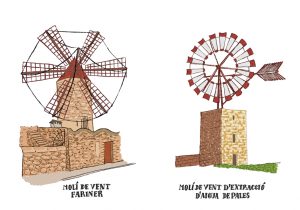
Molins
Un dels elements arquitectònics més característics del paisatge de Mallorca són els molins de vent. N´hi ha per tot, a Ciutat, als pobles i al mig del camp. Són un element clau i demostren les profundes arrels agràries de la nostra cultura. Es veu que a excepció de l’illa de Creta en cap lloc del món hi ha tants molins de vent com a Mallorca! Actualment en queden uns 3.300 en tot el territori. No són pocs, però ni va haver molts més! Només cal veure fotos del barri d’El Molinar, n’hi havia més de 50 i clar, van donar nom al barri, no podia ser menos! N´hi ha de dos tipus:
1-El molins fariners utilitzen la força del vent per moldre, principalment gra. Ja en trobem documentats al segle XIV i els caracteritzen les veles de tela que cobreixen les astes per ajudar a moure l’engranatge aprofitant el vent. És una estructura molt vinculada als camps de cereals, tan característics dels paisatges de l’interior de l’illa. De fet, molts d’ells tenen damunt de la porta una fornícula on es col·locava una figureta de Sant Llorenç o de Sant Antoni, patrons dels agricultors, o de Santa Bàrbara, que protegia el molí dels llamps. Si anau a Sineu, a Montuïri, i a quasi qualsevol dels nostres pobles, en veureu, n’hi ha d’abandonats, n´hi que estan restaurats i n’hi ha que els han convertit en restaurants!
2- Els molins aiguaders s’utilitzen per extreure aigua del subsòl amb la força del vent. Van arribar més tard, ja cap el XIX, de la mà de l’enginyer holandès Paul Bouvy, que va llançar la idea de dessecació del Pla de Sant Jordi, que en aquella època era un aiguamoll insalubre i es volia transformar en una zona de conreu. A diferència dels fariners, les pales estan fetes amb llistons de fusta que s’obren i es tanquen com un ventall, i tenen una cua en forma de fletxa que els orienta cap el vent. També tenen un safareig per dipositar l’aigua recollida. En trobareu al Pla de Sant Jordi -en queden encara uns 1.500!- i a Campos.
Per acabar, però, una reflexió: en molts casos, de tots aquests molins ara en queden esquelets que recorden un passat no tan llunyà en el que funcionaven. Després el turisme els va assumir com a símbol de propaganda de Mallorca, van allargar la llista de l’ensaïmada, la sobrassada, la Cova del Drac i els siurells. Però, ironies de la vida, aquests reclams turístics de les fotografies ara són, en realitat, un grapat de runes. L’illa que els exhibeix orgullosa, no els ha sabut protegir. I seria trist que els deixéssim anar esfondrant fins que desapareguin, ja que una part de nosaltres marxaria amb ells.
One of the most characteristic architectural elements of the landscape of Mallorca are windmills. They can be found anywhere: in town, in the villages and in the middle of the countryside. They are a key element and they demonstrate the deep agricultural roots of our culture. Apparently, except for the island of Crete, there is no place in the world that holds as many windmills as Mallorca! Currently there are about 3,300 in the entire territory. They are not few, but there used to be many more! You just have to see photos of the neighbourhood El Molinar, where there were more than 50, and hence the name they gave it! We can find two types of windmills in Mallorca:
The flour mills use the strength of the wind to mill grains, mainly. They have been documented as early as in the 14th century and they are characterised by the fabric sails that cover the blades to help move the gear using the wind. It is a structure closely linked to the cereal fields, which are so characteristic of the landscapes of the interior of the island. In fact, many of them have a niche with a figurine of Sant Llorenç or Sant Antoni, patrons of the farmers, or of Santa Barbara, who protected the mill from lightnings. If you go to Sineu, Montuïri, or almost any of our villages, you will see many of them, either abandoned or restored – some have been turned into restaurants!
Water mills are used to extract subsoil water with the force of the wind. They arrived later, already towards the 19th century, with the Dutch engineer Paul Bouvy. He launched the idea of drying up the Pla de Sant Jordi, which at that time was an unhealthy wetland, and transforming it into an area of crops. Unlike in the flour mills, their blades are made with wooden slats that open and close like a fan, and they have an arrow-shaped tail that directs them towards the wind. They also have a pond to deposit collected water. You will find them in the Pla de Sant Jordi – there are still about 1,500! – and in Campos.
To finish, here’s a thought: in many cases, these mills are now skeletons that remind us of a not so distant past, when they used to work. The tourism industry took them as a marketing symbol of Mallorca, extending the list to the ensaïmada, sobrassada, the Cova del Drac and the siurells. But, ironies of life, these tourist attractions in the photographs are now, in fact, a handful of ruins. The island that shows them proudly has not been able to protect them. And it would be sad that we let them go collapsing until they disappear, since a part of us would leave with them.
Text by Ben Mallorquí


+ There are no comments
Add yours